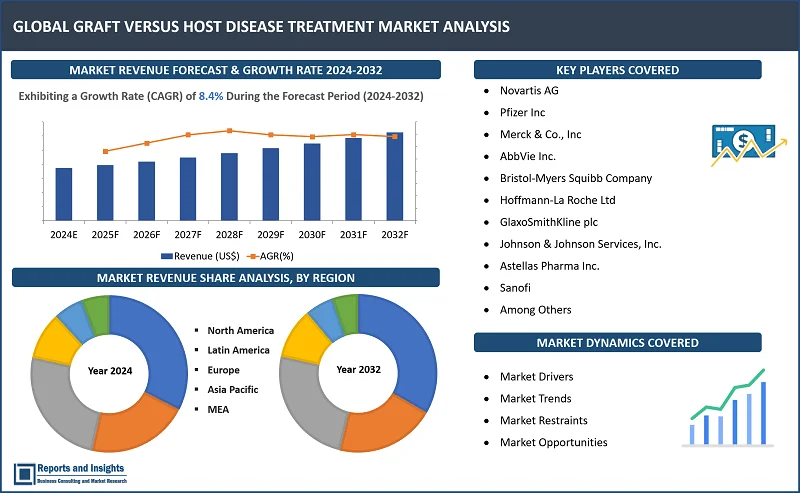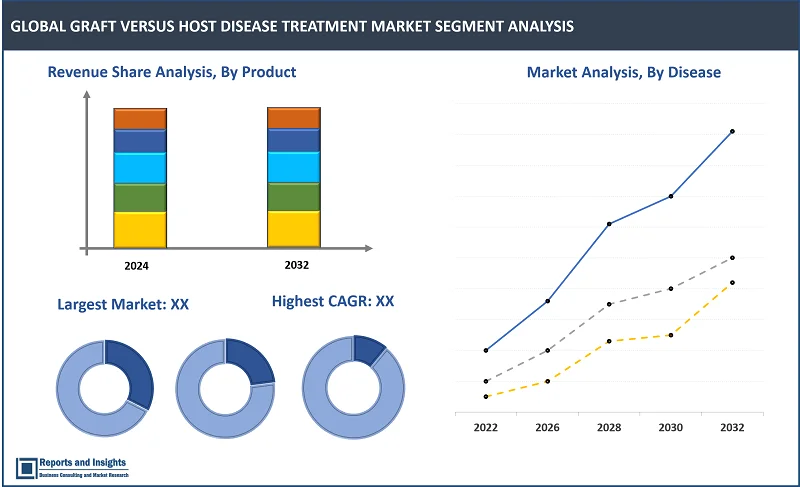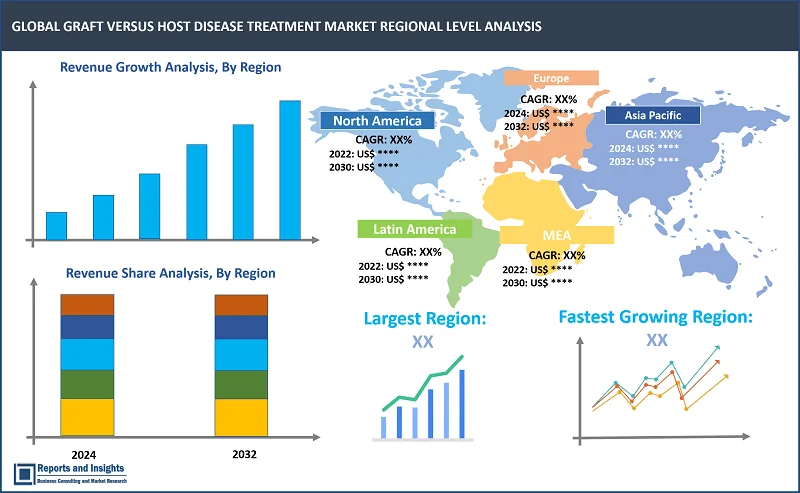Market Overview:
"The global graft versus host disease treatment market was valued at US$ 2,567.6 million in 2023 and is expected to register a CAGR of 8.4% over the forecast period and reach US$ 5,306.1 million in 2032."
|
Report Attributes |
Details |
|
Base Year |
2023 |
|
Forecast Years |
2024-2032 |
|
Historical Years |
2021-2023 |
|
Market Growth Rate (2024-2032) |
8.4% |
Graft-versus-host disease (GVHD) is a condition that can occur after a stem cell or bone marrow transplant, where the donor cells attack the recipient's body. It can be acute or chronic, affecting the skin, liver, and gastrointestinal tract. Treatment involves medications to suppress the immune response, such as immunosuppressive drugs or corticosteroids. Supportive care is also important, including skin care and nutritional support. Early detection and treatment are crucial for managing GVHD effectively.
The market for treating Graft Versus Host Disease (GVHD) is witnessing growth due to a rising demand for effective therapies following transplant procedures. This growth is fueled by innovative treatment approaches like targeted immunosuppressive agents and biologics, aiming to enhance patient outcomes. Moreover, increased investments in research and development, along with a growing emphasis on personalized medicine, are anticipated to drive market expansion. However, challenges such as high treatment expenses and the potential for adverse effects from immunosuppressive treatments could limit market growth.

Graft Versus Host Disease Treatment Market Trends and Drivers:
The market for treating Graft Versus Host Disease (GVHD) is experiencing notable growth, fueled by factors such as the increasing prevalence of hematopoietic stem cell transplantation (HSCT), advancements in transplant technologies, and greater awareness of GVHD. This market is marked by a rise in research and development efforts aimed at developing novel therapies, including biologics and cell-based treatments, to meet the needs of GVHD patients. Furthermore, the market is driven by the expansion of transplant centers and the enhancement of healthcare infrastructure in developing regions, which are improving the availability of GVHD treatments. These trends are expected to continue shaping the GVHD treatment market, fostering innovation, and enhancing patient care.
Graft Versus Host Disease Treatment Restraining Factors:
The Graft Versus Host Disease (GVHD) treatment market faces several constraints, including the high costs of advanced therapies, limited reimbursement policies, and the complexity of diagnosing and managing GVHD. Additionally, the absence of standardized treatment guidelines and the potential for adverse effects from immunosuppressive therapies present challenges to market growth. Moreover, there is a shortage of skilled healthcare professionals specializing in GVHD treatment, and limited awareness among patients and caregivers about available treatment options further hinder market expansion. These factors collectively impede the growth of the GVHD treatment market, underscoring the need for collaborative efforts among stakeholders to address these challenges and enhance patient outcomes.
Graft Versus Host Disease Treatment Market Opportunities:
The Graft Versus Host Disease (GVHD) treatment market offers significant opportunities for expansion and advancement. Increasing research and development efforts are focusing on innovative therapies like biologics and cell-based treatments, potentially introducing more efficient and precise GVHD treatments. Moreover, the rising prevalence of hematopoietic stem cell transplantation (HSCT) and the growth of transplant centers in developing regions are expanding the patient base, boosting the demand for GVHD therapies. Additionally, progress in diagnostic technologies and the rise of personalized medicine approaches provide opportunities to customize treatments based on individual patient requirements, enhancing treatment effectiveness and improving patient well-being.
Graft Versus Host Disease Treatment Market Segmentation:

By Product
- Monoclonal antibodies
- mTOR inhibitors
- Tyrosine kinase inhibitors
- Thalidomide
- Etanercept
The product type segment is categorised into monoclonal antibodies, mTOR inhibitors, tyrosine kinase inhibitors, thalidomide, etanercept. Among these, Monoclonal antibodies currently dominate the Graft Versus Host Disease (GVHD) treatment market due to their ability to target specific molecules involved in the immune response. This targeting helps reduce the risk of GVHD while maintaining the graft-versus-leukemia effect. Monoclonal antibodies are considered a fundamental aspect of GVHD treatment and are frequently used as the initial therapy for both acute and chronic GVHD. While other products like mTOR inhibitors, tyrosine kinase inhibitors, thalidomide, and etanercept also play significant roles in GVHD treatment, monoclonal antibodies are presently the most prevalent in the market.
By Disease
- Acute Graft Versus Host Disease (aGvHD)
- Chronic Graft Versus Host Disease (cGvHD)
The disease segment is categorised into acute graft versus host disease (aGvHD), chronic graft versus host disease (cGvHD). Both acute and chronic Graft Versus Host Disease (GVHD) are significant segments in the GVHD treatment market, with their dominance dependent on factors such as the transplant type, conditioning regimen, patient age, and other medical considerations. Acute GVHD, which manifests within the first 100 days post-transplant and affects the skin, liver, and gastrointestinal tract, can be life-threatening. On the other hand, chronic GVHD, developing after the initial 100 days, impacts multiple organs and is challenging to treat, significantly affecting patient quality of life. Treatment strategies for both forms are continually evolving, with research aimed at improving outcomes and reducing the burden on patients.
By Region

North America
- United States
- Canada
Europe
- Germany
- United Kingdom
- France
- Italy
- Spain
- Russia
- Poland
- Benelux
- Nordic
- Rest of Europe
Asia Pacific
- China
- Japan
- India
- South Korea
- ASEAN
- Australia & New Zealand
- Rest of Asia Pacific
Latin America
- Brazil
- Mexico
- Argentina
Middle East & Africa
- Saudi Arabia
- South Africa
- United Arab Emirates
- Israel
- Rest of MEA
North America stands out as the leading region in the graft versus host disease (GVHD) treatment market, largely due to its advanced healthcare infrastructure, substantial research and development investments, and a high incidence of hematologic malignancies requiring stem cell transplants, thus leading to a higher prevalence of GVHD. Europe closely follows, benefitting from a robust healthcare system and active participation in clinical research. The Asia Pacific region is also witnessing rapid growth in this market, driven by improving healthcare facilities and growing GVHD awareness. While Latin America and the Middle East & Africa are smaller markets, they are expected to expand with healthcare improvements and increased GVHD awareness.
Leading Graft Versus Host Disease Treatment Providers & Competitive Landscape:
The graft versus host disease treatment market is highly competitive, with several key players vying for market share and actively engaging in strategic initiatives. These companies focus on product innovation, technological advancements, and expanding their product portfolios to gain a competitive edge. These companies are continuously investing in research and development activities to enhance their product offerings and cater to the evolving needs of customers in terms of efficiency, performance, and sustainability.
These companies include:
- Novartis AG
- Pfizer Inc
- Merck & Co., Inc
- AbbVie Inc.
- Bristol-Myers Squibb Company
- Hoffmann-La Roche Ltd
- GlaxoSmithKline plc
- Johnson & Johnson Services, Inc.
- Astellas Pharma Inc.
- Sanofi
Research Scope
|
Report Metric |
Report Details |
|
Market size available for the years |
2021-2023 |
|
Base Year |
2023 |
|
Forecast Period |
2024-2032 |
|
Compound Annual Growth Rate (CAGR) |
Product, diseases, and regions. |
|
Segment covered |
8.4% |
|
Regions Covered |
North America: The U.S. & Canada Latin America: Brazil, Mexico, Argentina, & Rest of Latin America Asia Pacific: China, India, Japan, Australia & New Zealand, ASEAN, & Rest of Asia Pacific Europe: Germany, The U.K., France, Spain, Italy, Russia, Poland, BENELUX, NORDIC, & Rest of Europe The Middle East & Africa: Saudi Arabia, United Arab Emirates, South Africa, Egypt, Israel, and Rest of MEA |
|
Fastest Growing Country in Europe |
The U.K. |
|
Largest Market |
North America |
|
Key Players |
Novartis AG, Pfizer Inc, Merck & Co., Inc, AbbVie Inc., Bristol-Myers Squibb Company, Hoffmann-La Roche Ltd, GlaxoSmithKline plc, Johnson & Johnson Services, Inc., Astellas Pharma Inc. and Sanofi. |
Frequently Asked Question
At what CAGR will the graft versus host disease treatment market expand?
The market is anticipated to rise at 8.4% through 2032.
What is the market size of the graft versus host disease treatment market in 2023?
The graft versus host disease treatment market was valued at US$ 2,567.6 million in 2023
What are some key factors driving revenue growth of the graft versus host disease treatment market?
Some key factors driving market revenue growth include increasing incidence of hematologic malignancies, growing awareness and early diagnosis, expansion of healthcare infrastructure, and R&D investments.
What are some major challenges faced by companies in the graft versus host disease treatment market?
Companies face challenges such as complexity of GVHD, limited treatment options, high development costs, regulatory hurdles, long-term management, and access to patients.
Which is the fastest-growing country in Europe?
The U.K. is the fastest growing country in Europe
Who are the leading key players in graft versus host disease treatment market?
The leading key players in graft versus host disease treatment market are Novartis AG, Pfizer Inc, Merck & Co., Inc, AbbVie Inc., Bristol-Myers Squibb Company, Hoffmann-La Roche Ltd, GlaxoSmithKline plc, Johnson & Johnson Services, Inc., Astellas Pharma Inc. and Sanofi.
What are the symptoms of GVHD?
Acute GVHD symptoms are skin rash, diarrhea, and liver abnormalities. On the other hand, chronic GVHD is characterized by skin changes, dry eyes and mouth, joint pain, and lung problems.
Are there any new treatments or research for GVHD?
Ongoing research aims to create novel treatments for GVHD, such as targeted therapies and methods to lower GVHD risks while preserving the graft's ability to fight cancer.

